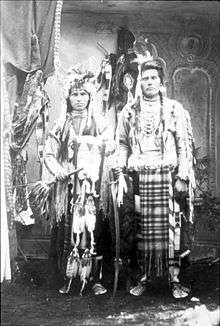Camas prairie

(Camassia quamash)
The name camas prairie refers to several distinct geographical areas in the western United States which were named for the native perennial camassia or camas, including regions in the states of Idaho, Montana, Oregon, and Washington. Camas bulbs were an important food source for Native Americans.
Idaho
History

Named for the blue flowering camas—an important food source for all Native Americans in the interior Northwest—the Camas Prairie is a traditional Nez Perce gathering place in north central Idaho.[1]
From the Nez Perce National Historical Park: Camas Prairie is interpreted at a highway pullout on the north side of U.S. Highway 95, about six miles (10 km) south of Grangeville.[2] This large prairie was a Nez Perce gathering place, where camas roots were harvested for thousands of years. Several nontreaty bands gathered at Tolo Lake in early June 1877 in anticipation of moving to the Nez Perce reservation. In response to the forced move and other hostile actions, several young Nez Perce people took actions that precipitated the Nez Perce War.
Camas Prairie is a large area, mostly privately owned, that extends many miles between the Salmon and Clearwater River drainages. Most of the area is agricultural and the northern section is within the Nez Perce Indian Reservation. Similar to the opening of lands in Oklahoma, the U.S. government opened the reservation for white settlement on November 18, 1895. The proclamation had been signed less than two weeks earlier by President Cleveland.[3][4][5][6]
The area was home to the second subdivision of the Camas Prairie Railroad,[7] known as the "railroad on stilts" due to its numerous trestles, most of which were timber. Breakheart Pass, a 1975 film starring Charles Bronson, was filmed on portions of the railroad on the Camas Prairie. The railroad ceased operations in the late 1990s.[8]
For more information:
- National Park Service - Nez Perce
- U.S. Forest Service - Nez Perce
Communities
Counties
|
Southern Idaho
In southern Idaho, east of Mountain Home, the high plain of Camas County around Fairfield is locally called the "Camas Prairie."[9][10][11]
Protected Areas
Montana
Geology
Cities
Counties
Oregon
Protected areas
- Camassia Natural Area in West Linn
Communities
Washington
Protected areas
Cities
See also
- Palouse prairie
References
- ↑ "Camas Prairie". Nez Perce National Historical Park. National Park Service. Retrieved April 13, 2016.
- ↑ Idaho Transportation Dept. - historical marker
- ↑ Hamilton, Ladd (June 25, 1961). "Heads were popping up all over the place". Lewiston Morning Tribune. Idaho. p. 14.
- ↑ Brammer, Rhonda (July 24, 1977). "Unruly mobs dashed to grab land when reservation opened". Lewiston Morning Tribune. Idaho. p. 6E.
- ↑ "3,000 took part in "sneak" when Nez Perce Reservation was opened". Lewiston Morning Tribune. Idaho. November 19, 1931. p. 3.
- ↑ "Nez Perce Reservation". Spokesman-Review. Spokane, Washington. December 11, 1921. p. 5.
- ↑ "Lewiston chamber honors Camas Prairie Railroad". Spokesman-Review. Spokane, Washington. September 29, 1959. p. 6.
- ↑ WWV Railway.com - Camas Prairie RR - second subdivision
- 1 2 3 "Camas Prairie". U.S. Forest Service. Sawtooth National Forest. Retrieved April 13, 2016.
- 1 2 3 "Camas Prairie Centennial Marsh Wildlife Management Area". Idaho Department of Fish and Game. Retrieved April 13, 2016.
- 1 2 "History". Camas County Chamber of Commerce. Retrieved April 13, 2016.
- ↑ "FirstVoices: Nature / Environment - place names: words. Ktunaxa.". Retrieved 2012-07-07.
- ↑ "FirstVoices: Nature / Environment - place names: words. Ktunaxa.". Retrieved 2012-07-07.
External links
- Visit North Central Idaho – Camas Prairie
- Eye of Idaho – Around Camas Prairie
- Idaho Public TV – Camas Prairie Railroad
- Historical Museum at St. Gertrude
- Monastery of St. Gertrude
- Glacial Lake Missoula.org – Camas Prairie ripple marks in Montana